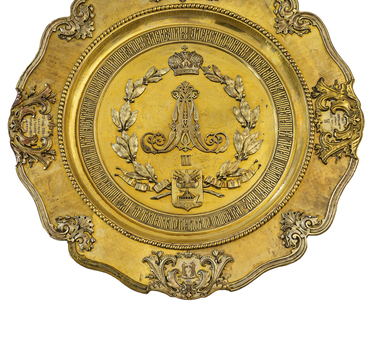The bust of Emperor Alexander II belongs to the so-called “office” trend of iron casting. It is characterized by a clear silhouette, careful detailing, and high-quality matte Dutch soot painting. Such soot is produced by the precipitation of smoke during the burning of organic matter with a weak supply of air. The burning of wood produces low-quality soot; the high quality and expensive soot used in painting is obtained from the burning of petroleum, oils, and tar.
One of the most famous iron foundries remains the Kaslinsky plant in the Urals, which employed several famous dynasties of founders and molders. The Teplyakov dynasty is one of them. The dynasty’s founder was a serf peasant Sidor Teplyakov, born about 1741, who worked at the Kaslinsky ironworks.
The history of the Kaslinsky casting began in 1747. When four years later the factory was taken over by the Demidov princes, local ironware was already widely known in Europe and Asia. Since 1809, the production began to attract new talented sculptors, painters, engravers, and molders. For example, graduates of the Saint Petersburg Academy of Arts Mikhail Kanaev and Nikolay Bakh, who later organized an art school at the factory, came to Kasli.
The period from the 1860s to the 1890s is considered the heyday of Kasli iron art casting. At that time, the plant received a Minor Gold Medal from the Free Economic Society. Works of local masters were shown at Russian and foreign exhibitions. At the All-Russian Exhibition in Nizhny Novgorod in 1896, the Kasli masters for the first time presented their goods in an openwork cast-iron pavilion. In addition, for the Paris world exhibition of applied art in 1900, they cast a huge cast-iron pavilion-palace in the Byzantine style, designed by Eugene Baumgarten. The centerpiece of the pavilion was the sculpture “Russia”, created by Nikolay Laveretsky. The pavilion received high marks from critics and the highest award, “the Grand Prix”. At the exhibition, many people wanted to buy the pavilion together with all the exhibits in it, including the statue. The Russian representatives agreed to sell the pavilion but without the sculpture. They declared, “Russia was not for sale”. The deal did not go through; the boxes with the parts of the pavilion returned to the Urals and for a long time lay in the basement of a private house in Kasli.
One of the most famous iron foundries remains the Kaslinsky plant in the Urals, which employed several famous dynasties of founders and molders. The Teplyakov dynasty is one of them. The dynasty’s founder was a serf peasant Sidor Teplyakov, born about 1741, who worked at the Kaslinsky ironworks.
The history of the Kaslinsky casting began in 1747. When four years later the factory was taken over by the Demidov princes, local ironware was already widely known in Europe and Asia. Since 1809, the production began to attract new talented sculptors, painters, engravers, and molders. For example, graduates of the Saint Petersburg Academy of Arts Mikhail Kanaev and Nikolay Bakh, who later organized an art school at the factory, came to Kasli.
The period from the 1860s to the 1890s is considered the heyday of Kasli iron art casting. At that time, the plant received a Minor Gold Medal from the Free Economic Society. Works of local masters were shown at Russian and foreign exhibitions. At the All-Russian Exhibition in Nizhny Novgorod in 1896, the Kasli masters for the first time presented their goods in an openwork cast-iron pavilion. In addition, for the Paris world exhibition of applied art in 1900, they cast a huge cast-iron pavilion-palace in the Byzantine style, designed by Eugene Baumgarten. The centerpiece of the pavilion was the sculpture “Russia”, created by Nikolay Laveretsky. The pavilion received high marks from critics and the highest award, “the Grand Prix”. At the exhibition, many people wanted to buy the pavilion together with all the exhibits in it, including the statue. The Russian representatives agreed to sell the pavilion but without the sculpture. They declared, “Russia was not for sale”. The deal did not go through; the boxes with the parts of the pavilion returned to the Urals and for a long time lay in the basement of a private house in Kasli.



